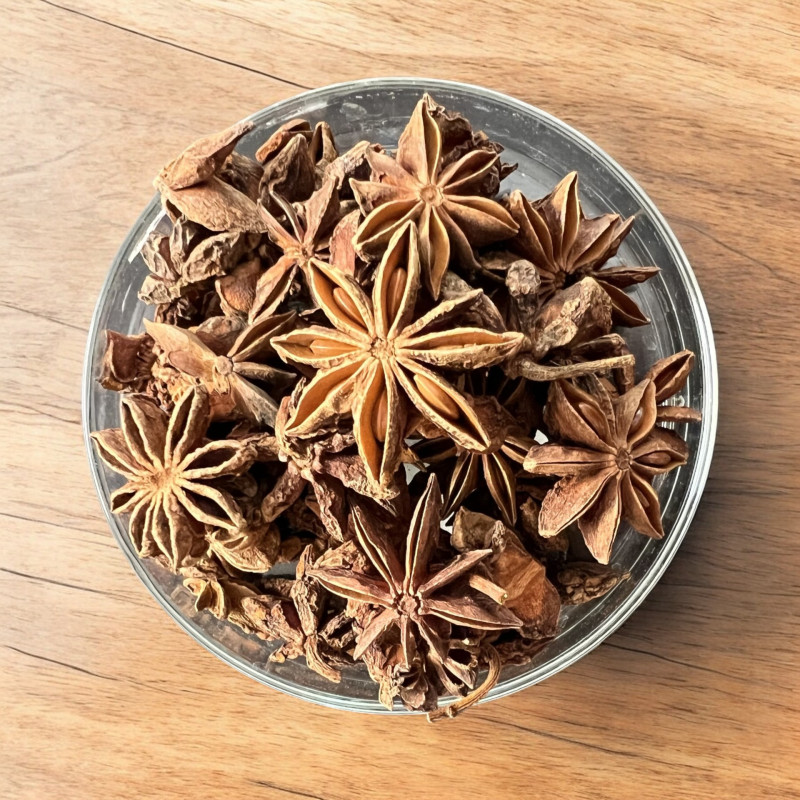- Reduced price




Its flavor is intensely aniseed, very fresh, and its shape is beautiful!
It is excellent for digestive teas and anise-flavored spirits, but also works wonderfully in a fish soup or even infused in a fruit salad.
 Delivery
Delivery
Mondial Relay
 Returns
Returns
See conditions
 Payments
Payments
100% secure
Produit livré en sachet refermable
Uses in Cooking:
Its aniseed and fresh aroma is more powerful than that of green anise, primarily due to the anethole it contains.
Star anise is widely used in Europe for making spirits (such as pastis and ouzo), where it has gradually replaced traditional green anise.
In baking, it can be used either ground or infused in warm milk or another liquid to flavor cakes, including gingerbread. It’s also excellent in certain jams (like melon), as well as with fish (especially alongside ginger), and in fish soups, to which it imparts an unparalleled aroma.
Star anise is an essential ingredient in mulled wines, along with cinnamon and a few cloves. For those who enjoy its taste, it can also be infused into fruit salads.
After use, the star anise can be rinsed and dried to serve as a component in potpourri or as a decorative element for the home. You can keep it natural, or, if you prefer, spray-paint it gold to decorate a Christmas tree or a festive table during the holidays!
In an infusion, using 3 or 4 stars per cup of boiling water (steep for several minutes, reheating if necessary), it helps relieve bloating by aiding digestion. Star anise is also one of the many active compounds found in Tamiflu, a recognized antiviral for human, avian, and swine flus.
Who am I?
Origin: China
Scientific name: Illicium verum Hook
Common names: Siberian anise, Chinese fennel
The fruit is stunning, with its warm brown color, shiny seeds inside the "stars," and its delightful anise aroma! It generally consists of 8 boat-shaped follicles of varying sizes, arranged radially around a central stem. Due to the product's fragility, some stars may break during handling.
Star anise is the fruit of a tropical shrub from the Magnoliaceae family, the Chinese star anise tree, and 90% of the world's production is harvested in China's Jiangxi province. The tree is also found in Cambodia and Vietnam. It can grow up to 8 meters tall, with green, elongated, and evergreen leaves. The flowers are large and yellow. The fruit consists of an eight-pointed star, each point containing a shiny seed.
The fruits are harvested green before being sun-dried to turn reddish-brown. There are two harvests per year, in April and October.
There is also a Japanese star anise, banned from import into France due to its toxicity in high doses.
A Little History:
Star anise has been used in China since ancient times for its medicinal properties.
It was introduced to Europe during the time of Marco Polo and used by practitioners of the era. However, it did not become widely used until the Renaissance when it was imported by the English.
In the Middle Ages, star anise was rare, highly coveted, and therefore very expensive.
Data sheet
Reference: 11N7892701
Reference: fenouilE
Reference: vinchaud
Reference: 108017302
Reference: EPI230204
Reference: 00033929-0001
Reference: 6470
Reference: 050721
Reference: 7N7525705
Reference: badianeM
Reference: 3N7137901
Reference: ecorcecitronH
Reference: 10M6821604
Reference: 3913
Reference: 2M6273801
Reference: bergamote
Reference: cardamomeverteE
Reference: 6N7456401
Reference: 26545D

Its flavor is intensely aniseed, very fresh, and its shape is beautiful!
It is excellent for digestive teas and anise-flavored spirits, but also works wonderfully in a fish soup or even infused in a fruit salad.